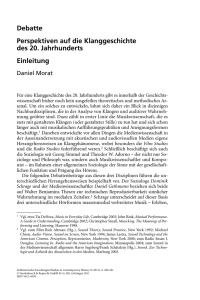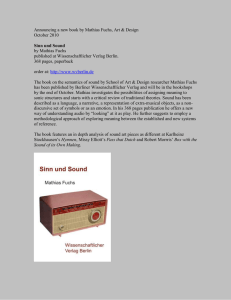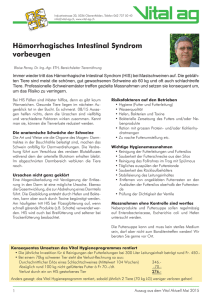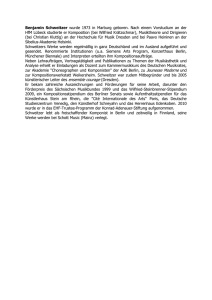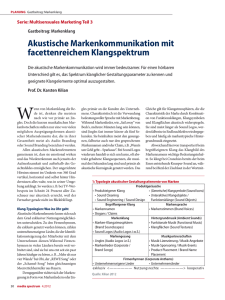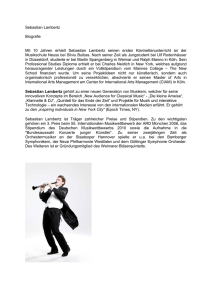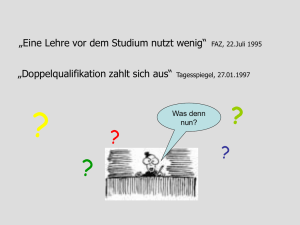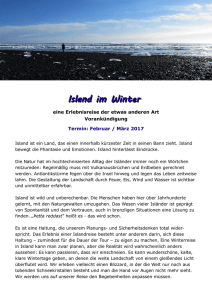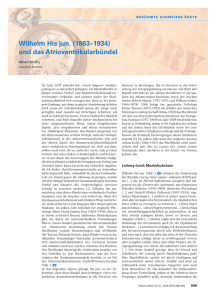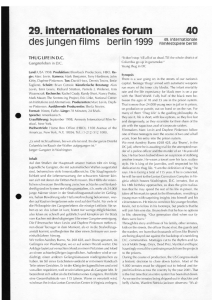Re-mapping Europe - European Media Art Festival
Werbung
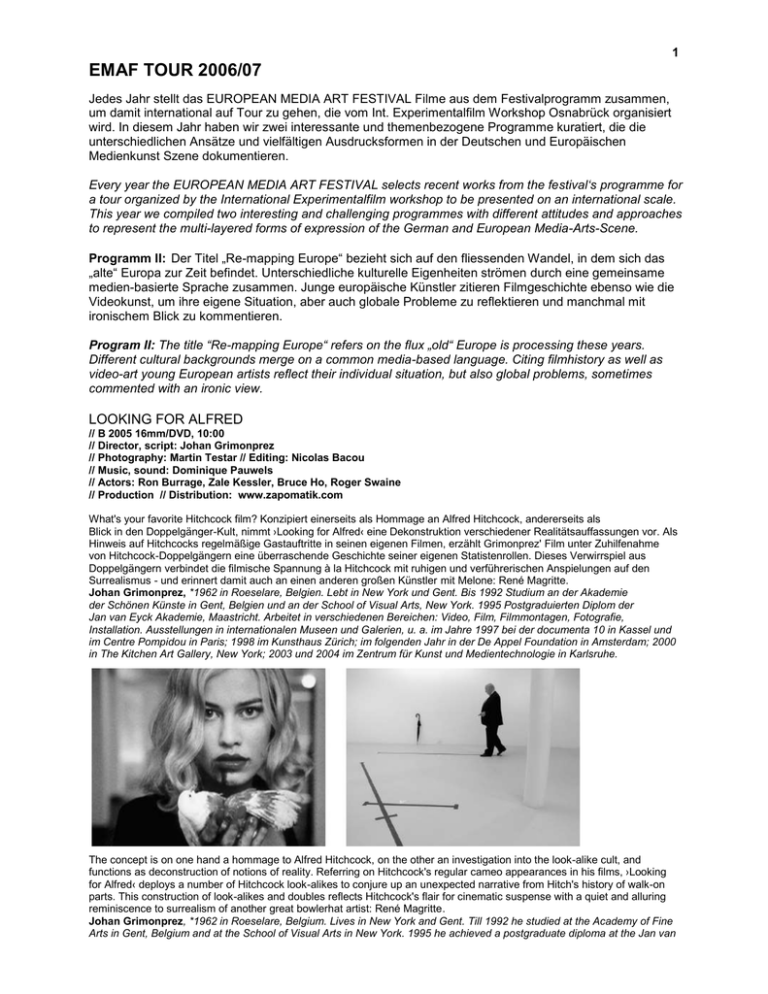
1 EMAF TOUR 2006/07 Jedes Jahr stellt das EUROPEAN MEDIA ART FESTIVAL Filme aus dem Festivalprogramm zusammen, um damit international auf Tour zu gehen, die vom Int. Experimentalfilm Workshop Osnabrück organisiert wird. In diesem Jahr haben wir zwei interessante und themenbezogene Programme kuratiert, die die unterschiedlichen Ansätze und vielfältigen Ausdrucksformen in der Deutschen und Europäischen Medienkunst Szene dokumentieren. Every year the EUROPEAN MEDIA ART FESTIVAL selects recent works from the festival‘s programme for a tour organized by the International Experimentalfilm workshop to be presented on an international scale. This year we compiled two interesting and challenging programmes with different attitudes and approaches to represent the multi-layered forms of expression of the German and European Media-Arts-Scene. Programm II: Der Titel „Re-mapping Europe“ bezieht sich auf den fliessenden Wandel, in dem sich das „alte“ Europa zur Zeit befindet. Unterschiedliche kulturelle Eigenheiten strömen durch eine gemeinsame medien-basierte Sprache zusammen. Junge europäische Künstler zitieren Filmgeschichte ebenso wie die Videokunst, um ihre eigene Situation, aber auch globale Probleme zu reflektieren und manchmal mit ironischem Blick zu kommentieren. Program II: The title “Re-mapping Europe“ refers on the flux „old“ Europe is processing these years. Different cultural backgrounds merge on a common media-based language. Citing filmhistory as well as video-art young European artists reflect their individual situation, but also global problems, sometimes commented with an ironic view. LOOKING FOR ALFRED // B 2005 16mm/DVD, 10:00 // Director, script: Johan Grimonprez // Photography: Martin Testar // Editing: Nicolas Bacou // Music, sound: Dominique Pauwels // Actors: Ron Burrage, Zale Kessler, Bruce Ho, Roger Swaine // Production // Distribution: www.zapomatik.com What's your favorite Hitchcock film? Konzipiert einerseits als Hommage an Alfred Hitchcock, andererseits als Blick in den Doppelgänger-Kult, nimmt ›Looking for Alfred‹ eine Dekonstruktion verschiedener Realitätsauffassungen vor. Als Hinweis auf Hitchcocks regelmäßige Gastauftritte in seinen eigenen Filmen, erzählt Grimonprez' Film unter Zuhilfenahme von Hitchcock-Doppelgängern eine überraschende Geschichte seiner eigenen Statistenrollen. Dieses Verwirrspiel aus Doppelgängern verbindet die filmische Spannung à la Hitchcock mit ruhigen und verführerischen Anspielungen auf den Surrealismus - und erinnert damit auch an einen anderen großen Künstler mit Melone: René Magritte. Johan Grimonprez, *1962 in Roeselare, Belgien. Lebt in New York und Gent. Bis 1992 Studium an der Akademie der Schönen Künste in Gent, Belgien und an der School of Visual Arts, New York. 1995 Postgraduierten Diplom der Jan van Eyck Akademie, Maastricht. Arbeitet in verschiedenen Bereichen: Video, Film, Filmmontagen, Fotografie, Installation. Ausstellungen in internationalen Museen und Galerien, u. a. im Jahre 1997 bei der documenta 10 in Kassel und im Centre Pompidou in Paris; 1998 im Kunsthaus Zürich; im folgenden Jahr in der De Appel Foundation in Amsterdam; 2000 in The Kitchen Art Gallery, New York; 2003 und 2004 im Zentrum für Kunst und Medientechnologie in Karlsruhe. The concept is on one hand a hommage to Alfred Hitchcock, on the other an investigation into the look-alike cult, and functions as deconstruction of notions of reality. Referring on Hitchcock's regular cameo appearances in his films, ›Looking for Alfred‹ deploys a number of Hitchcock look-alikes to conjure up an unexpected narrative from Hitch's history of walk-on parts. This construction of look-alikes and doubles reflects Hitchcock's flair for cinematic suspense with a quiet and alluring reminiscence to surrealism of another great bowlerhat artist: René Magritte. Johan Grimonprez, *1962 in Roeselare, Belgium. Lives in New York and Gent. Till 1992 he studied at the Academy of Fine Arts in Gent, Belgium and at the School of Visual Arts in New York. 1995 he achieved a postgraduate diploma at the Jan van 2 Eyck Academy, Maastricht, Netherlands. He works with several different media: video, film, montage, photography, installation. Works shown internationally, in 1997 at the documenta 10, Kassel, Centre Pompidou, Paris, in 1998 at the Kunsthaus, Zurich, in 1999 at De Appel Foundation, Amsterdam, in 2000 at The Kitchen Art Gallery, New York; 2003 and 2004 at ZKM, Karlsruhe. VERTIGO // NL 2005, Mini DV, 1:35 // Realisation: Regina Kelaita // Distribution: www.reginakelaita.com Ich lehnte mich aus dem Fenster und schaute über die Straße, als der Bürgersteig mir diese hanebüchene Geschichte erzählte... Hier ist sie. Regina Kelaita, *1979 in Bonn, Deutschland, als Kind einer deutsche Mutter und eines persischen (irakischen) Vaters aufgewachsen in England und Deutschland. Von 1999 bis 2000 am Chelsea College für Kunst und Design, London, England. Von 2000 bis 2005 BA ›cum laude‹ in Bildende Kunst an der Gerrit Rietveld Academie, Amsterdam, Niederlande. 2005 ›Expressions by young photographers in Germany‹, Konika Minolta Plaza, Tokio. Nominiert beim theoneminuteawards Xiamen, China. 2006 Bloody Burps, Veemvloer, Amsterdam. I was leaning out of the window looking down over the street, when the pavement told me this cock-n-bull story… This is how it went. Regina Kelaita, *1979 in Bonn, Germany to a German mother and an Assyrian (Iraqi) father, brought up in England and Germany. 1999-2000 Chelsea College of Art and Design, London, England. 2000-2005 BA ›cum laude‹ Fine Arts Gerrit Rietveld Academie, Amsterdam, the Netherlands. 2005 ›Expressions by young photographers in Germany‹ , Konika Minolta Plaza, Tokyo. Nomination in theoneminuteawards Xiamen, China. 2006 Bloody Burps, Veemvloer, Amsterdam. MIRROR MECHANICS // A 2005, 35 mm, 7:30 // Director, concept & realization: Siegfried A. Fruhauf // Sound: Jürgen Gruber // Distribution: www.sixpackfilm.com Ein Mädchen mit nassem Haar blickt in Mirror Mechanics in einen Badezimmerspiegel, wischt mit einer Handbewegung über dessen Oberfläche: Das Bild, das diese Szene zeigt, ist selbst, entlang der Mittelachse, gespiegelt, zu einer Art Doppelprojektion verfremdet. Das ist der Ausgangspunkt: Siegfried A. Fruhauf unterzieht sein Material einer Reihe komplexer Transformationen, legt verschieden bearbeitete Bildschichten, Doppelspiegelungen und Mehrfachbelichtungen über- und ineinander. Jürgen Grubers nuancierter Soundtrack, komponiert aus angedeuteten Gitarrenfeedbacks und elektronischen Klangdetails, gibt dem Film eine Aura schwelender Aggression: die Grundierung eines Thrillers. (...) Die letzte und entscheidende Spiegelung in Mirror Mechanics führt schließlich von innen nach außen: hin zu sanft bewegten Wasseroberflächen und einer Rückkehr zur perfekten Symmetrie, zu einer Szene am Strand, in das zerkratzte Filmspiegelbild eines namenlosen Mädchens mit nassem Haar. (Stefan Grissemann) Siegfried A. Fruhauf, *1976 in Grieskirchen, Oberösterreich. Seit 1993 Experimente mit Video und später auch Film. Seit 1995 Studium an der Hochschule für künstlerische und industrielle Gestaltung in Linz, Meisterklasse für experimentelle visuelle Gestaltung. Diverse Arbeiten und Ausstellungen. 2002 Förderpreis für Filmkunst des Bundeskanzleramts. 3 In Mirror Mechanics, a young woman with wet hair glances in a bathroom mirror. She wipes across the surface with a brush of the hand: the picture that shows this scene is mirrored along the center axis, alienated in a type of double projection. That is the starting point: Siegfried A. Fruhauf subjects his material to a series of complex transformations, overlapping and intertwining variously processed image layers, double reflections, and multiple exposures. Jürgen Gruber's subtle soundtrack composed from intimated guitar feedback and electronic sound details gives the film an aura of smoldering aggression: the foundations of a thriller. (…) The final and most decisive reflection in Mirror Mechanics finally leads from the inside to the outside: toward gently rippling surfaces of water and a return to perfect symmetry, to a scene at the beach, in the scratched film reflection, an anonymous young woman with wet hair. (Stefan Grissemann, Translation: Lisa Rosenblatt) Siegfried A. Fruhauf, *1976 in Grieskirchen, Upper Austria. Since 1993 experiments with video and film. Since 1995 studies at the University for Design in Linz. Various work and shows in the area of video and film. 2002 Supportive Award for Filmart. OPTICAL SOUND / OPTINEN ÄÄNI // FIN 2005, 35 mm, 6:00 // Director, editor, script: Mika Taanila // Cinematography, script, photos: Jussi Eerola // Music and concept: [The User] - E. Madan / T. Mcintosh © Socan 2005 // Sound recording, audio consultant: Olli Huhtanen // Distribution: www.kinotar.com Technische Bürogeräte haben schnell ausgedient. Alte Geräte werden zu Musikinstrumenten. Der Film basiert auf der Sinfonie #2 für 12-Nadeldrucker, komponiert von [The User]. Die Musik wird nur von Nadeldruckern gemacht: kein Mischen, kein anderer Sound und ein Minimum an elektronischer Verarbeitung. ›Optical Sound‹ (2005) wurde von Filmkritikern als ›ein sofortiger Klassiker, ungezähmt expressionistisch, hypnotisches Meisterstück abstrakten Kinos‹ beschrieben. Es ist ein auf der Sinfonie #2 für Nadeldrucker der kanadischen Gruppe [The User] basierender 6-minutiger Kurzfilm. Ausgediente Bürotechnologien werden zukünftige Musikinstrumente. Der Film ist eine Ohrwurmmischung aus wunderschönen Bildern, schmutzigen Bildern aus Überwachungskameras und einer groben Animation, die direkt, ohne Kamera, auf den Film fotokopiert wurde. ›Die Filme von Mika Taanila geben uns kostbare Einblicke in eine verlorene Ära der idealistischen Gedanken und Innovationen. Themen, oft einfach als eigenartiger Kitsch abgetan, werden mit Respekt und aufgrund ihrer Leistungen und Bestrebungen behandelt.‹ (Mark Webber, The Guardian) Mika Taanila, *1965 in Helsinki, lebt und arbeitet in Helsinki. Mika Taanila ist ein Künstler, der auf den Gebieten des dokumentarischen und Avantgarde-Filmemachens und der visuellen Künste arbeitet. Seine Filme handeln von künstlicher, urbaner Umgebung und futuristischen Utopien zeitgenössischer Wissenschaft. Optical Sound setzt die Filmreihe von Mika Taanila fort, die von der Technologie, der Menschheit und futuristischen Ideen handelt. Office technology becomes obsolete very quickly. Old tools transform into musical instruments. The film is based on the Symphony # 2 for 12 Dot Matrix Printers, composed by [The User]. The music is made using only the sounds of dot matrix printers: no sampling, no other sound sources and a minimum of electronic processing. ›Optical Sound‹ (2005) has been described by film critics as ›an instant classic, wildly expressionistic, hypnotic masterpiece of abstract cinema‹. It is a sixminute short film based on The Symphony #2 for Dot Matrix Printers by the Canadian group [The User]. Obsolete office technology transforms into musical instruments of the future. The film is a haunting mix of beautiful cinematography, dirty security camera footage, and rough animation photocopied straight onto clear film without camera. ›The films of Mika Taanila 4 give us precious glimpses into a lost era of idealistic thought and innovation. Topics that might easily be dismissed as kitsch oddities are treated with respect and for their achievements and aspirations.‹ (Mark Webber, The Guardian) Mika Taanila, *1965 in Helsinki, lives and works in Helsinki. Mika Taanila is an artist working fluently in the fields of documentary film-making, avant-garde film-making and visual arts. His films deal with the issues of urban artificial surroundings and futuristic utopias of contemporary science. Optical sound continues the series of films by Mika Taanila, which deal with technology, humanity, and futuristic ideas. PAUL AND THE BADGER - EPISODE 1 // GB 2005, Betacam, 11:30 // Realisation: Paul Tarragó // Distribution: [email protected] Der Anblick eines künstlichen Skeletts bringt Erinnerungen von Badger ans Tageslicht, die er all die Jahre unterdrückt hatte. Er bringt ihn dazu, sehr delikate Antworten auf einige sehr heikle Fragen über Leben und Tod von seinem Freund Paul zu verlangen. Die Badger-Reihe (2005-6) besteht aus vier Episoden eines simulierten Fernsehprogramms, gleich viele Teile moralischer Anweisungen und erzählerischen Spiels, vermittelt durch einen dazu gezwungenen experimentellen Filmemacher als Kinderunterhalter. Paul Tarragó: ›Ich bin ein künstlerischer Filme- und Videomacher und schufte an bewegten Bildern in Süd-London. Meine Arbeit? Eine Mischung aus Undergroundexperiment und Metafiktion, die an der Leine der Filmsprache zerrt, bei der aber das Erzählerische nicht zu kurz kommt. Wenn ich keine Arbeiten mache, verbringe ich meine Zeit - und verdiene mein Geld - am University College for the Creative Arts als Dozent.‹ Die Badger-Reihe wurde im September/Oktober 2005 in der Deluge Contemporary Arts Gallery, Kanada als Teil einer 2-Personenshow (mit Jennet Thomas) eines neues Videowerkes mit dem Titel ›We Make Our Own Television‹ uraufgeführt, welches das Antimatter International Film Festival eröffnete. The sight of a model skeleton unearths a memory in Badger that he has repressed all these years. It prompts him to demand some pretty delicate answers to some pretty tricky questions about life and death from his good friend Paul. The Badger series (2005-6) consists of four episodes of a simulated television programme, equal parts moral instruction and narrative play, mediated through the forced fit of an experimental film-maker as children's entertainer. Paul Tarragó: ›I'm an artist film and video maker, beavering away with moving images down is South London. My work? A mix of underground experimentation and metafiction, tugging at the leash of film language but with narrative often held close at hand. When not making work I spend my time - and earn my living - teaching at University College for the Creative Arts.‹ Sept/Oct 05 - The Badger series premiered at Deluge Contemporary Arts Gallery, Canada as part of a two-person show (with Jennet Thomas) of new video work entitled ›We Make Our Own Television‹, launching the Antimatter Int. Film Festival. STILL // NL 2005, 16mm, 5:00 // Director, script, photography, production: Tim Leyendekker // sound assistance: Barbara Pella, Joost van Veen // cast: M. Jaro Wolff, Maarten van Krimpen // Distribution: www.filmbank.nl 1989: Zwei männliche Teenager verabreden sich zu ihrem ersten Date über eine telefonische Partnervermittlung. Ein kurzer Film über Sehnsucht und Erinnerung. Für diesen Kurzfilm ging der Autor an genau den Platz zurück, wo er seine ersten sexuellen Erfahrungen machte. Die zu hörende telefonische Unterhaltung begründet sich auf seine 16 Jahre alten Tagebuchaufzeichnungen. Die Schauspieler haben das gleiche Alter wie er und sein Partner damals. Tim Leyendekker, *1973, arbeitete einige Jahre als künstlerischer Leiter für Kurzfilme und entschied sich 2000 für den Eintritt in die Willem de Kooning Academy for Fine Arts, Rotterdam, um Video Künstler/Filmemacher zu werden. Während seines Studiums entwickelte er Arbeiten, die nicht so sehr medienbasiert sind, sondern die das Konzept als Ausgangspunkt nehmen. Seine Arbeiten bestehen aus Videos, Filmen und Musik, einschließlich des Gebrauchs von Zeichnungen, Seidensiebdrucken, Performances usw., um sein künstlerisches Werk zu artikulieren. 5 1989: two male teenagers make their first date through a telephone dating line. A short film about longing and memory. For this short film the maker went back to the exact place where he had his first sexual encounter. The telephone conversation that can be heard in the soundtrack is based on diary notes he wrote 16 years ago. The actors are the same age as he and his partner were at that time. Tim Leyendekker, *1973, worked for some years as an art director for short films and decided in 2000 to attend the Willem de Kooning Academy for Fine Arts, Rotterdam, with the intention of becoming a video artist/film-maker. During this educational programme he developed an oeuvre that is not so much medium-based but always uses the concept as a starting point. His works consist of video, film and audio works which include the use of drawings, silk screens, sculptures, performances, etc., to articulate his artistic output. PATRIOTIC // F/CDN 2005, miniDV, 4:05 // Benny Nemerofsky Ramsay & Pascal Lièvre // Distribution: www.montevideo.nl ›Patriotic‹ dreht sich um den kontroversen ›Patriot Act‹, der nach den Anschlägen des 11. September vom US Kongress erlassen wurde. Sie greifen die Passagen heraus, die die Sicherheit der USA und den Kampf gegen den Terrorismus betreffen. Das Resultat ist eine zuckersüße, vielstimmige Ode an die USA mit einem klar homoerotischen Unterton. ›Patriotic‹ strotzt vor bombastischer, drastischer Rhetorik und singenden Soldaten in Phantasie-Uniformen. Sie singen so kraftvoll sie nur können zu Celine Dions Titanic-Hit ‹My Heart Will Go On‹. Die Ironie ist unverkennbar: eine perfekte Kriegspropaganda-Parodie. Benny Nemerofsky kommt aus Montréal, Pascal Lièvre aus Paris. Erst vor ein paar Jahren haben die beiden - völlig unabhängig voneinander - angefangen mit Video zu experimentieren. Als sie sich zum ersten Mal trafen, stellten sie fest, dass sie eine tiefe Liebe zur Popmusik verbindet. Benny präsentierte seine Version von Madonnas ›Live to Tell‹ Pascal mixt Popmusik mit politischen Reden wie in ›Axis of Evil‹ den amerikanischen Päsidenten mit Jermaine Jackson et Pia Zadoras ›When the rain begins to fall‹ oder Abbas ›Money Money Money‹ mit einer Mao-Rede. Their new joint performance-tape ›Patriotic‹ revolves around the controversial ›Patriot Act‹, which was enacted by the US Congress following the attacks of 9/11. They pick out the passages relating to the security of the USA and the fight against terror. The result it a sweet ode to the USA for several voices with clear homoerotic undertones. ›Patriotic‹ is full of bombastic, drastic rhetoric and singing soldiers in imaginary uniforms. The two sing as loudly as they can to Celine Dion's hit from the Titanic ‹My Heart Will Go On‹. The irony is unmistakable: a perfect war propaganda parody. Benny Nemerofsky comes from Montréal, Pascal Lièvre lives in Paris. Both of them started experimenting with video just a few years ago - completely independently of one another. When they initially met, they realised that an intense love of pop music unites them. Benny presented his version of Madonna's ›Live to Tell‹ or stages joint casting with the girl group ›TATU‹. Pascal combines pop music with political speeches. He effortlessly manages to link Abba's ›Money Money Money‹ to a speech by Mao. 6 AMERICA PUNISH CRIMINALS // S 2005, DVD, 4:04 // Director, animation, Peter E Bengtsson // Script, sound, music: Peter Friess, Peter E Bengtsson // Distribution: www.furiefilm.com ›America punish criminals‹ ist ein kurzes Experiment über die Invasion im Irak und die Rede, mit der George Bush sie rechtfertigt. Da wir alle wissen, was im Gefängnis von Abu Ghurayb geschah (und noch immer in Guantánamo Bay geschieht), im Namen des ›Krieges gegen den Terrorismus‹, will uns dieser Film daran erinnern, was der wahre Grund für die Invasion im Irak war. Meiner Ansicht nach ging es da mehr um Öl und wirtschaftliche Gründe als um die Rettung des irakischen Volkes. Dieser Experimentalfilm kratzt bloß an der Oberfläche dieser Themen, trotzdem denke ich, dass er eine gute Diskussionsbasis bildet. ›Amerika sieht sich einem Feind gegenüber, der weder die Genfer Konventionen beachtet noch die Gesetze der Moral‹, doch die Frage ist: Wer ist der Feind? Peter E Bengtsson, 1998-2001 Film- und TV-Produktion am Sturegymnasiet in Halmstad. 2003-2004 The Swedish School of Television. Seit 2001 arbeitet er in verschiedener Form in den Bereichen Film, Fernsehen und Kunst. Seit einigen Jahren produziert er mit seiner Frau und Kollegin Margareta Ek in der Produktionsfirma FuRiEFiLM Kurzfilme und Animationen für das schwedische Fernsehen und andere. America punish criminals is a short experiment about the invasion of Iraq and the invasion speech made by George W Bush. Since we all know what happened in the Abu Ghurayb Prison (and still happens on Guantánamo Bay) in the name of ›War against terrorism‹ this movie makes a quite striking reminder about the true purpose of the Iraq invasion. In my point of view it had more to do with oil and economics than the rescue of the Iraq people. This experimental movie only scratches some kind of surface on these subjects but I still think it's all right as a ground for discussion. ›America faces an enemy who has no regard for conventions of war or rules of morality‹, but the question is, who is the enemy? Peter E Bengtsson, 1998-2001 Film and TV production at Sturegymnasiet in Halmstad. 2003-2004 The Swedish School of Television. He has been working with film, television and art in various forms since 2001. For a few years he has been producing short film and animations, for Swedish TV and other, with his wife and college Margareta Ek in the Production Company FuRiEFiLM SEA CHANGE // GB 2005, Betacam, 5;28 // Directors: Joe King & Rosie Pedlow, // Photography: Peter Ellmore // Music: Simon Allen // Producer: Slinky Pictures, Liz Chan // Distribution: www.slinkypics.com Am Ende der Saison in einem Wohnwagen-Park an der englischen Küste gedreht, enthüllt ›Sea Change‹ eine durch Licht und Zeit sich dramatisch verändernde Landschaft im Einklang mit der Vergänglichkeit menschlicher Gegenwart. Joe King und Rosie Pedlow teilen sich in London ein Studio, arbeiten zusammen und unabhängig von einander an ihren Fertigkeiten mit bewegten Bildern. ›Sea Change‹ ist ihre erste echte Zusammenarbeit. Bei ihrem letzten Werk liegt das Hauptaugenmerk auf Ideen über Orte, Landschaften, Zeitabläufe und menschliche Gegenwart. Ihre Filme wurden für viele Preise vorgeschlagen und auf internationalen Film- und Medienkunst-Festivals gezeigt. Filmed on a caravan park on the English coast at the end of the season, ›Sea Change‹ reveals a landscape dramatically transformed by light and time, and resonating with the transience of human presence. Joe King and Rosie Pedlow share a studio in London, working together and independently on their moving image practice. ›Sea Change‹ is their first true collaboration. The main concerns of their recent work have to do with ideas of place, landscape, passage of time and human presence. Their films have been nominated for many awards and screened internationally at film and media art festivals. 7 10 YEARS IN RIVER // LT 2005, DVD, 1:00 // Realisation: Audrius Kasperavicius // Distributuion: [email protected] Zehn Sommer lang fuhr ich den größten litauischen Fluss hinab. Zehn Sommer lang war der Nenumas mein Zuhause und bot den größten Schatz: Frieden. Der Film besteht aus zehn Momentaufnahmen. Für jedes Jahr, das ich auf dem Fluss verbrachte, eine Momentaufnahme. Die Musik basiert auf einem traditionellen litauischen Volkslied. Es besingt alle kleineren Flüsse, die in die Nemunas münden. Audrius Kasperavicius, *1980. BA in Foto- und Medien-Kunst an der Vilnius Art Academy. Arbeitete als Cutter der kommerziellen Fernsehprojekte ›Be tabu‹, ›Gintarine ledi‹, ›Meiles trikampis‹, ›D _iungles‹ für die Produktionsfirma ›Be tabu ir Ko‹. Initiierte zwei alternative Musikprojekte. 2000 Kurzfilm ›Palydovas‹ (›Begleiter‹), 2001 Experimentalfilme ›Vienodi‹ (›Das Gleiche‹), ›I/iš‹ (›An/von‹), ›Vakaras su knyga‹ (›Abend mit einem Buch‹). 2002 Kurzdokumentation ›Neatsipleši nuo _emes‹ (›Du wirst nicht abheben‹) und 2003 ›Laurynas Gucevicius‹ (›Laurynas Gucevicius‹). 2004-2005 Dokumentarfilm ›Nemunas‹ in Spielfilmlänge. For ten summers I travelled down the biggest Lithuanian river. For ten summers the Nemunas river was my home, and the biggest treasure I found there was peace. This film is made of ten blinks. One blink for one year I spent on the river. The soundtrack is based on a traditional Lithuanian folk song. It names all the smaller rivers that flow into the Nemunas. Audrius Kasperavicius, *1980. BA in Photography and MediaArt from Vilnius Art Academy. Worked for the production company ›Be tabu ir Ko‹ as editor of the commercial TV projects ›Be tabu‹, ›Gintarine ledi‹, ›Meiles trikampis‹, ›D _iungles‹. Initiator of two alternative music projects. 2000 short ›Palydovas‹ (›Attendant‹), 2001 experimental films ›Vienodi‹ (›The Same‹), ›I/iš‹ (›To/from‹), ›Vakaras su knyga‹ (›Evening with a book‹). 2002 short docu ›Neatsipleši nuo _emes‹ (›You won't get off the ground‹). 2003 short docu ›Laurynas Gucevicius‹. 2004-2005 full-length documentary ›Nemunas‹. WIR SIND DIR TREU // D / CH 2005, 35mm, 9:05 // Director, script, editing, co-producer: Michael Koch // Cinematography: Andrea Gsell, Michael Koch // Sound: Nica Giuliani // Sound Editor: Ralf Schipke // Distribution: www.khm.de Spiel für Spiel stellt sich der Anstimmer des FC Basel in den Dienst der Mannschaft. Er ist derjenige, der die Lieder anstimmt, die Fans choreographiert und zu Höchstleistungen motiviert. Es geht dabei um das Wechselspiel von Energien. Dabei muss er sowohl auf die Fans wie auch auf das Spiel reagieren, sonst lösen sich die Strukturen unweigerlich auf. Michael Koch, *1982 in Luzern, Schweiz, 1999-2004 Schauspieler in diversen Theaterstücken und Filmen. Seit 2003 Studium an der KHM, Köln, Fächergruppe Film/Fernsehen. Arbeitet zurzeit am Kurzfilm ›Beckenrand‹. The Swiss football team FC Basel's crowd animator gives his all for the team: he decides what music to sing at matches and choreographs the fans to peak performance. It's all about the energy and emotion he transmits to the fans and how he directs them. Or is it rather the game itself that the fans follow? 8 Michael Koch, *1982 in Lucerne, Switzerland, 1999-2004 actor in a variety of plays and films. Has been studying Film/Television at the Kunsthochschule für Medien Köln since 2003. Currently making a short film called ›Beckenrand‹. APPLE ON A TREE // D 2005-2006, Mini DV, 4:50 // Director, idea, post-produktion: Astrid Rieger, Željko Vidovic // Photography: Mark Liedtke // Music: Phoenix the Devourer ›Apple On A Tree‹ // Distribution: www.zeljkovidovic.com Er vermisst sein Leben als Apfel, denn Mensch zu sein ist nicht so einfach, wie er dachte. Astrid Rieger, *1979, in Kronstadt, Rumänien, studiert seit 1999 Visuelle Kommunikation an der Hochschule für Gestaltung Offenbach. Zeljko Vidovic, *1975 in Livno, lebt und arbeitet in Offenbach am Main. He desperately misses his life as an apple, because being a man is not as simple as he had thought. Astrid Rieger, *1979, in Kronstadt, Romania, is studying Visual Communication at the Hochschule für Gestaltung Offenbach since 1999. Zeljko Vidovic, *1975 in Livno, lives and works in Offenbach am Main. END
